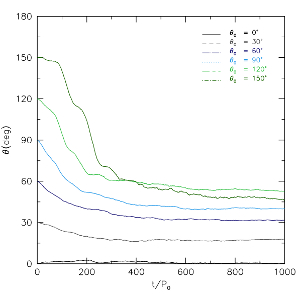|
|  |
In the standard cosmological scenario of structure formation, galaxies
assemble through successive mergers of larger and larger systems (see
Fig. 1 for images of interacting galaxies). Apart from larger galaxies,
this also leads to the formation of pairs of massive black holes, called
black hole binaries (see Fig. 2 for an illustration), in their centres.
Stars that undergo a close encounter with a black hole binary tend to
extract energy and angular momentum from the binary, and are ejected to
larger distances, while the orbital separation of the binary shrinks. If
enough energy is transferred to the stellar population, the black holes
come so close that eventually they merge in a burst of gravitational
waves. Calculations of the evolution of black hole binaries generally
assume spherically symmetric galaxy models. During mergers, however,
strong perturbations are produced, which lead to significant deviations
from spherical symmetry and to rotation.
So how do black hole binaries evolve in realistic merger remnants? To
answer this question, scientists at the Max Planck Institute for
Astrophysics and international collaborators performed a series of
numerical simulations of galaxy mergers as well as black hole binaries
immersed in rotating merger remnants. In these calculations, the
gravitational forces between all pairs of particles in the galaxies are
computed and very accurate trajectories are derived.
Simulating the merger of two galaxies using highly accurate numerical
methods is an extremely challenging computational task, and required
more than one year of uninterrupted computations on the GPU machines at
the Max Planck Institute for Astrophysics and on the special purpose
GRAPE cluster at the Rochester Institute of Technology (Rochester, USA).
The results of these calculations, however, are very interesting.
The evolution of black hole binaries in spherically symmetric galaxies
is characterized by a first phase, where the binary separation shrinks,
followed by a stalling phase of very slow orbital decay. In contrast,
the evolution in realistic merger remnants proceeds to very small
separations - separations that are small enough that the emission of
gravitational waves becomes dominant and the black holes coalesce to
form a single black hole.
Simulations of black hole binaries in rotating systems also show that
the eccentricity of the binary evolves, where the nature of this
evolution (to a more or less eccentric orbit) depends on the degree of
co-rotation in the stellar cusp. As the separation of the two black
holes shrinks due to close encounters with stars, the orbit will
circularize in time, if a large fraction of stars co-rotate with the
binary. However, if most stars move on counter-rotating orbits, the
binary becomes more eccentric. The latter effect, which could arise as a
result of mergers between galaxies of different mass, has important
implications for the possible detection of gravitational waves emitted
by coalescing black hole binaries.
In addition, if the angular momentum of the binary is initially
misaligned with respect to that of the stellar system, a reorientation
of the binary orbital plane occurs. In spherically symmetric models,
the orientation of the binary plane suffers only small changes on long
timescales due to a kind of random walk process as interacting stars
exchange angular momentum with the binary. If, on the other hand, the
binary is immersed in a stellar system with net rotation where the
angular momentum is misaligned, it tends to realign its orbital plane
with the angular momentum of the stars. This reorientation takes place
on the same timescale over which the separation shrinks
and can be quite significant, with changes as large as
100 degrees.
The realignment of the binary plane seen in the simulations may have
significant implications for astrophysical observations. The direction
of the spin axis of the single black hole that results from the ultimate
merger of the binary is affected by the orientation of the binary plane
before coalescence. The spin axis, in turn, determines the orientation
of the accretion disk around the remnant black hole and, in radio-loud
systems, the direction of the radio jet.
Alessia Gualandris
References:
Alessia Gualandris & David Merritt,
"Long-term evolution of massive black hole binaries. IV. Mergers of
galaxies with collisionally relaxed nuclei",
2011, ApJ, in press,
 http://arxiv.org/abs/1107.4095 http://arxiv.org/abs/1107.4095
Alberto Sesana, Alessia Gualandris, Massimo Dotti,
"Massive black hole binary eccentricity in rotating stellar systems",
2011, MNRAS, 415L, 35
 http://arxiv.org/abs/1105.0670 http://arxiv.org/abs/1105.0670
Alessia Gualandris, Massimo Dotti, Alberto Sesana,
"Massive black hole binary plane reorientation in rotating stellar systems",
2011, MNRAS,
 http://arxiv.org/abs/1109.3707 http://arxiv.org/abs/1109.3707
|




